– I am still struggling with feline echos, getting good quality images and differentiting between normal and mild hypertrophy.
– I sometimes think I can see SAM but cannot always document it on M-mode.
– I also find it hard to document source of murmur if no abnormalities found. Sometimes I will get turbulence in LVOT +/- MV but will often disappear when I increase the NL.
– Cat in the first two videos and images below is a 2 year old DSH with a moderate intensity left sided murmur. Does this look like a normal cat?
– I am still struggling with feline echos, getting good quality images and differentiting between normal and mild hypertrophy.
– I sometimes think I can see SAM but cannot always document it on M-mode.
– I also find it hard to document source of murmur if no abnormalities found. Sometimes I will get turbulence in LVOT +/- MV but will often disappear when I increase the NL.
– Cat in the first two videos and images below is a 2 year old DSH with a moderate intensity left sided murmur. Does this look like a normal cat?
– Cat in 3rd and 4th videos and images below is an overweight 2 year old DSH with a soft left sided murmur. Sorry about the poor quality, any tips welcome. Is there mild hypertrophy? Can you tell cause of murmur?
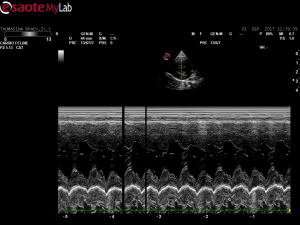
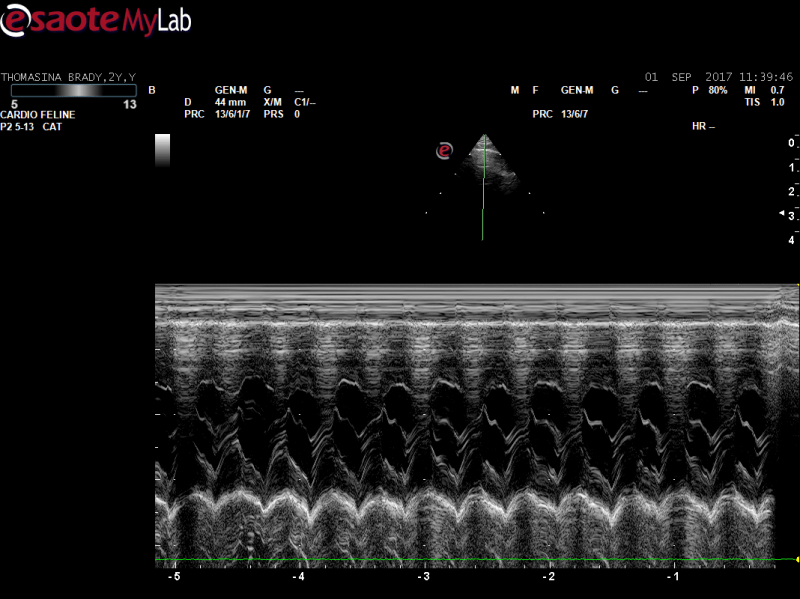
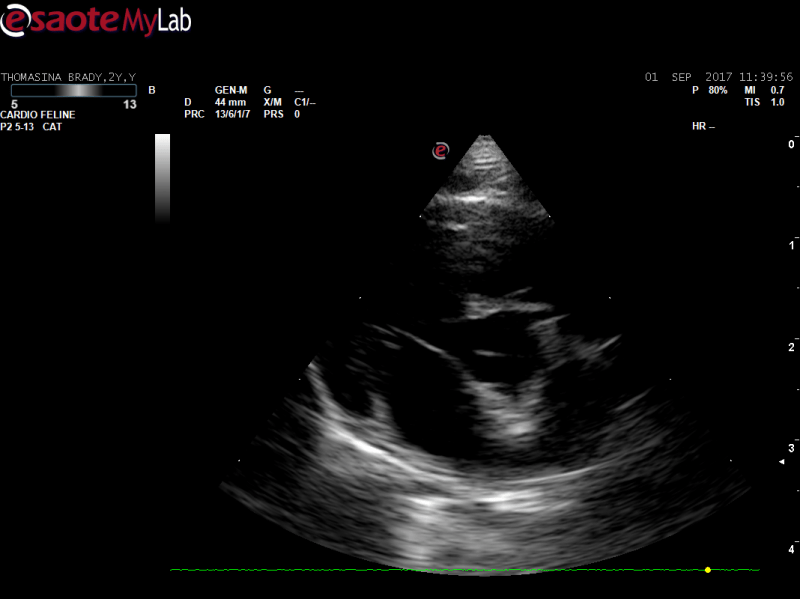
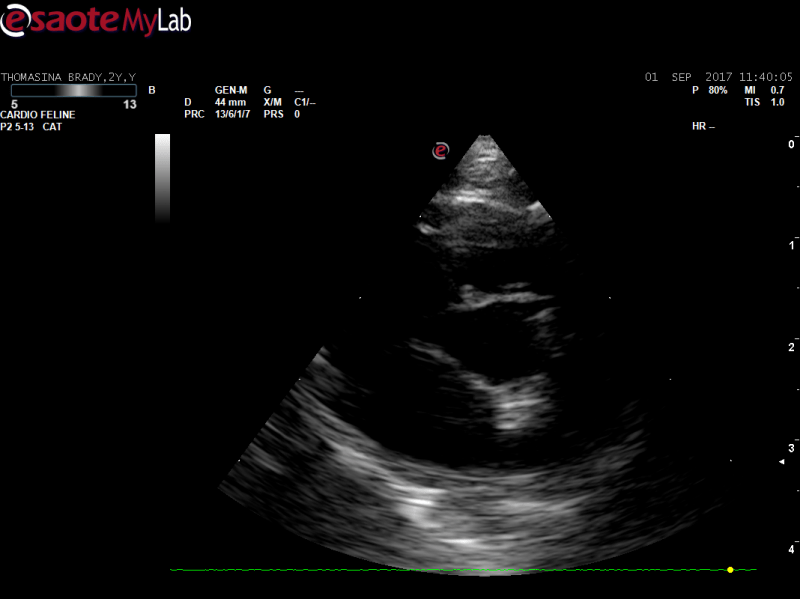
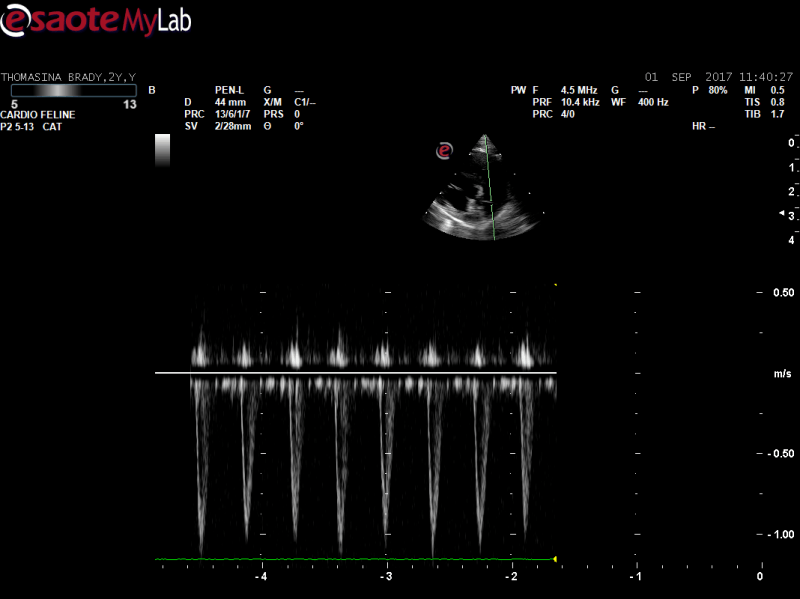


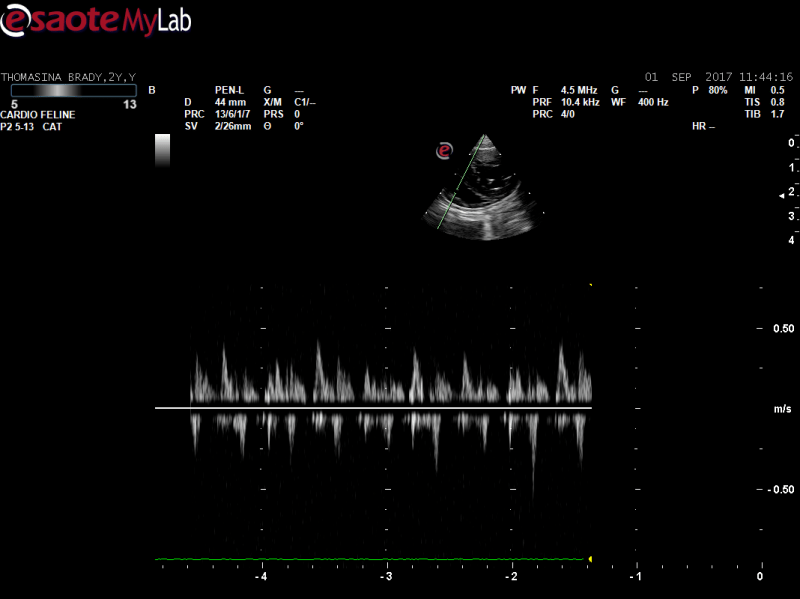

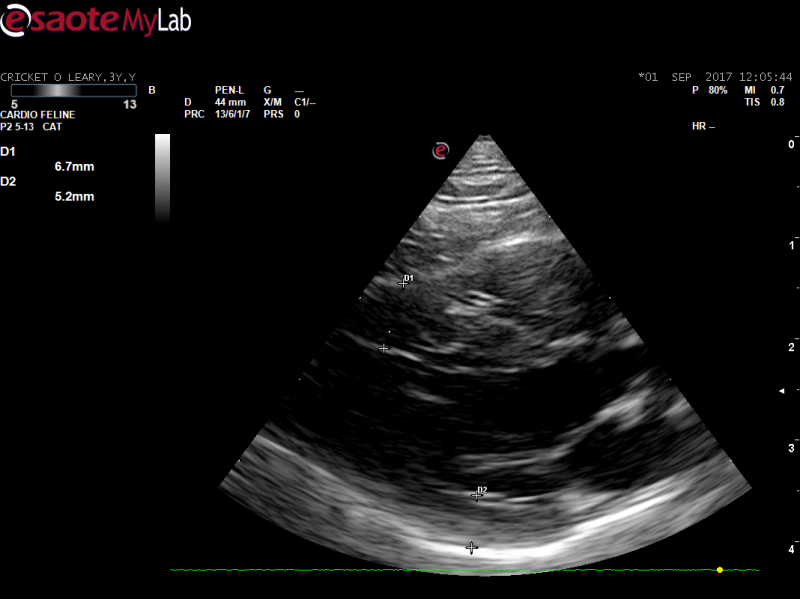
Comments
Benign flow murmurs are very
Benign flow murmurs are very common in cats and we dont always find the cause. Remember color flow aliases at 90 m/sec so you will have normal mosaic flows on the lvot in normal cats… essentially the macien cant jkeep its color up in th eprocessor with a cat heart:) Its th espectral doppler that counts.
You are off line with your LVOT and hitting the ao flow at a 45 degree angle or so which will dampen your veloicity. You need to slide the probe higher on the chest and flatten the probe parallel with the sternum. This is the toughest maneuver in cat echos. In dogs its easy to go direct subxyphoid but more difficult in cats because of the ao angle expecially in older cats. So either your true lvot is > 2 m/sec (auduible murmur range roughly) and that is your murmur or its a benign murmur as I dont see anything morphologically here but its just my set of eyes Peter or others may see something.
I made a video on this lvot adjustment on cats let me see if my techs can link it here
Here is the link to all of
Here is the link to all of our videos in the SonoPath.com video library:
http://www.sonopath.com/resources/ultrasound-resources/sonopaths-complete-ultrasound-video-library
And a direct link to the aortic velocity video on youtube:
Obtaining Aortic Velocity in Cats
I don’t see much in the way
I don’t see much in the way of wall change and LA/AO looks normal in both cats. Attached is a screen shot of the comparison of the Aorta and L atrium in the second cat. Look very similar in size.
I would also suggest you consider in some cases Dynamic Right Ventricular Outflow Tract Obstruction. Below article is from 2002.
New Cause of Systolic Murmurs in Cats
Thanks.
Thanks.
Thanks for vídeo Eric, very
Thanks for vídeo Eric, very helpful 🙂 This probe is the 8C, right? Are there advantages to using it in relation to phased array in cats? I ask this because I am in the process of buying an ultrasound, and for now I can only acquire three transducers (echo/abdominal us).
I use the 8c or the 6s in cat
I use the 8c or the 6s in cat echo until aliasing jets occur then go to the 6 s phased array.
if buying the logic e the 8c will do all the abdomen and most of the cat hearts with aliasing jets going to the 6s. The 8c makes prettier b mode images. Other cardiac 6s 60% of the echos completely and 3s the other 40% mainly for dogs over 30#. The 6s will underestimate hi velocity flows like mr jets so I just move to the 3srs on the next gen when doing that flow. The linear really makes a nice footprint but of the 4 I would put that one aside as in parctice i use it the least but I would still highly encourage the 4 probes as I use all of them every day even if the linear only for a few seconds for artistic ultrasound but they are usually key images like mucosal fogging and pretty adrenals, micronodular spleens and such…. spend a little more on all 4 and liver the probe better and keep all 4 out ready to use on a dime.
Thanks for the warning Eric!
Thanks for the warning Eric! I really thought 3S was more used than 6S, I was wrong. Today I trained this view that you taught in the video, it was not completely parallel to the ultrasound beam, but it’s a training question, thank you very much! do you have any video of how to go apical on a cat? Alias, in what situations are you apical in dogs and cats?
Have a great week,
Adams.
Yes check out this forum
Yes check out this forum thread and the youtube videos that help with apical in cats. Apical view is always a part fo the normal echo. There are lots of things to see here at different angles than the right parasternal views.
https://sonopath.com/forum/murmur-cat-hcm-or-not#comment-5107
Re the 3s and the 6s the 6s
Re the 3s and the 6s the 6s will give a cleaner image but again doesnt do medium – large dog doppler as well despite what they tell you when selling the machine and trying to keep the price low by not selling you the extra probe.
When you do an MR velocity in a springer with mvd for example the 6s may give you an MR velocity of 5.3 m/sec and 6 mHz and in th esame position the 3s (3srs in the next gen as the old logic e 3s doesnt work in the next gen fyi) will give you the actual MR velocity of 6 m/sec which is systemic hypertension level. Its usually semantics but you dont want to be on the bad end of that when doing a congential SAS or PS echo for example or if another person doing the followup echo and wants to “nit pick” your work… unfortunately it happens and this is one spot it can happen if you dont have the right probe on for the right patient.
Regarding being fully informed of a product Im goign to go on a little reality rant here so excuse me for dropping my political correctness a notch btu its important ot know how things work since its your investment and SonoPath is here for you first and not the sales industry even thoguh we do plenty for them as well. So I’m going to open up my black book of knowledge of the industry a little here:
Most salepeople that sell that machine tell you the complete story as I know most of them but some do not expecially 3rd party. Remember sales guys dont typically scan clinically so they just don’t know these fine lines of probe capacity as well as they should sometimes. Some do… in fact in europe many sales guys do actually scan clinically and take a mcgyver approach to the machine knowledge. The Austrian Rep for Esaote Erich Hauslauer is this way and is exemplary of how US sales should be done. He is the correct mold for us sales but realize in reality he is the exception. And remember this is not just a logic e thing as these concepts are universal with any machine and sales.
Side note: I wrote a long article on the reality if US sales and clinical sonography curve called:
“Things to Remember When Buying an Ultrasound Machine & Addressing the Curve; The machine, the curve, the “me too” ultrasound industry, and the reality.”
Its under review for publication so hopefully it gets out there and I can send the link to it but if it doesnt Ill publish it myself through sonopath. It tells the reality of the industry from a buyer’s perspective since I’ve lived extensively on both ends of the spectrum and know the eclosed door conversations int he industry all to well. But it may not be easy to publish by some of the mainstream journals so we will see what happens:)
Great argument Eric! Indeed,
Great argument Eric! Indeed, this is the crucial point in selling ultrasound: they are sold by people who do not use them in the clinical routine. Coincidentally (or not), here in Brazil, the only person who pointed out the four transducers was a seller of esaote, who is also a veterinarian and performs echocardiography and abdominal ultrasound exams routinely. As the purpose of this forum is the exchange of ideas and examples, I will expose the current situation of Brazil in this area:
– Our currency (The Real), is worth 3.3 times less than the dollar. So a dollar equals 3 reais and 30 cents (roughly, it varies with the exchange rate).
– A used Logiq E costs 55,000 reais
– A new Logiq E costs 120,000 reais
– A new M-turbo Sonosite costs 95,000 reais
– A new Esaote costs 120,000 reais
And even with these exorbitant prices (because of the high Brazilian tax burden), we do not find vendors that actually use the equipment they sell, I thought that was just here, but by their report, this situation is recurrent in other countries too! I really want to read your article on the subject, waiting!
Regards,
Adams.
Adam,
120,000 reals comes to
Adam,
120,000 reals comes to a little over 36,000 US dollars.
I don’t know which model- but that does not seem all that much different than here in the states. Probably comes with 1 probe. Each additional probe could cost close to 5,000 USD.
Another consideration would be the warranty. A warranty on the machine and probes could be 2500/year.
Their newest veterinary machine comes with a 3 year warranty.
I think you can negotiate with the vendor. I personally would be willing to pay more for the unit and ask for added years on the warranty.
Like EL said- 4 probes would be nice- but you could always add the linear probe at a later date.
For Echo’s you will need a lower frequency probe for Spectral doppler. To start you may be able to use the abdominal probe to get m mode information
I think once you get going and making money on ultrasounds you would be able to add probes.
Indeed randyhermandvm ! After
Indeed randyhermandvm ! After this post I’m only considering taking all four 🙂 In addition, it is necessary to carry out the insurance of the device, against theft and / or car accidents. Is there a need where you live/work? (for who is mobile)!
Thanks Everyone Nice Thread!
Thanks Everyone Nice Thread!